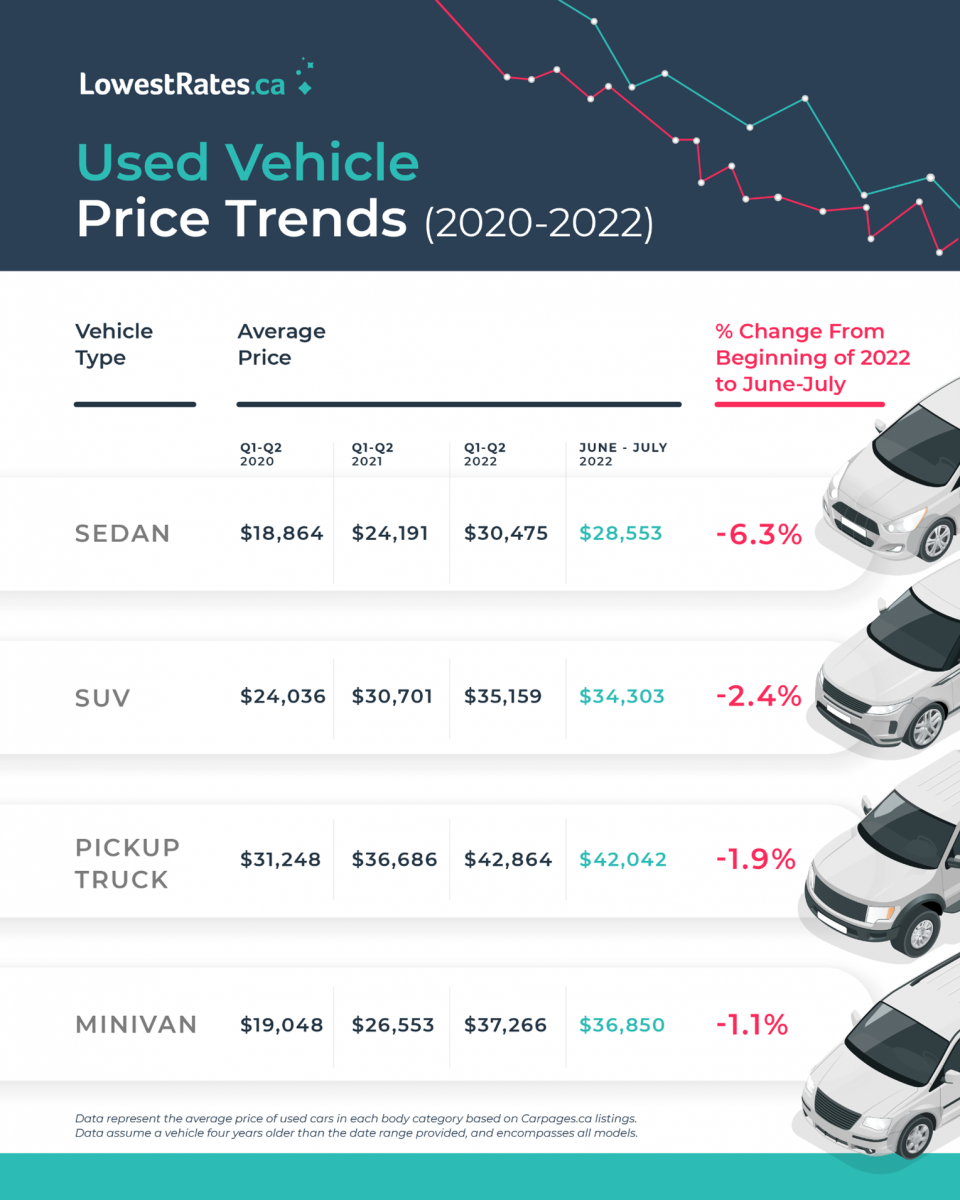REPORT: Used car prices in Canada may finally be easing
By: Michelle Bates on September 8, 2022
Key findings:
- Since June 2022, the average listing price for used cars on Carpages.ca has started to decrease but is still high compared to pre-pandemic prices.
- Wholesale used vehicle prices are dropping, making room for retail prices to eventually follow.
- Volume of new car production is increasing but isn’t expected to return to normal until 2023 due to ongoing pandemic-related chip shortages.
Prior to COVID-19, used vehicles were typically an accessible and affordable option for drivers. However, the pandemic had an adverse effect on both the supply and cost of used cars across Canada.
Supply chain delays decreased new vehicle production, causing the demand for used vehicles to skyrocket — along with their value. Fortunately, after a year and a half, used vehicle prices appear to have reached their peak in the first and second quarter of 2022.
Carpages.ca data show that between June and July 2022, used car prices have unofficially started their descent back to normality. However, list prices remain well above that of a buyers’ market, with some vehicles seeing sharper drops than others.
Used car prices dropped from June to July, still high compared to pre-pandemic
According to Carpages.ca listings data, the average price of a used vehicle has increased every year since 2020 — until June of this year, when prices across four segments: sedan, minivan, pickup truck, and SUV — all started to fall.
Though used vehicle prices have started to fall, supply remains low, which can yield a slower decline. But the end of Q2 and the start of Q3 offer a promising start for prospective buyers.
Pre-owned sedans have experienced the largest drop in average price point. Between June and July, the average Carpages.ca listing price for a used sedan dipped 6% from the first two quarters of the year, from $30,475 to $28,553.
Meanwhile, the average cost of a used pickup truck and SUV both dropped by only about 2% in the same time frame. The average price of a used pickup truck decreased from $42,684 to $42,042, and the average price of a used SUV dipped from $35,159 to $34,303.

“Sedans have been a weaker vehicle type over the last, let’s say five years, whereas pickup trucks have been a huge seller, growing year – over year,” says Ben Mirecki, president of Carpages.ca. “SUVs as well.”
The slowing demand for sedans compared to other vehicle types could be reflected in these price drops. “Ford, for example, stopped making sedans completely a few years ago,” says Mirecki.
Minivans, however, declined the least in price at the turn of the third quarter, seeing only a 1% drop in average price ($36,850 from $37,266).
“They're holding their value more than other vehicle types,” says Mirecki. “You buy a minivan when you need one, so the demand is more constant. If you have a family with kids, that's kind of the best option.”
However, despite the average cost of used vehicles falling between June and July, pickup trucks still cost 35% more than they did in the first two quarters of 2020, SUVs cost 43% more, sedans cost 51% more, and minivans cost 93% more.
Wholesale prices at vehicle auctions are declining, retail prices to follow
According to the Canadian Black Book (CBB), wholesale dealership auction prices continue a downward trend. Eventually, Mirecki says, the decrease in wholesale pricing will be reflected in retail prices.
“The prices that consumers are paying typically lag behind the wholesale prices by maybe a month or two,” says Mirecki. “The price that dealers are paying for cars at the auction are lower now than they were a month ago and that kind of indicates that prices will keep coming down for consumers.”
According to the CBB, consumer demand for used vehicles in the retail space has slightly weakened. Therefore, lower used vehicle values at auctions could not only be attributed to the progression of new vehicle production, but a dip in consumer shopping.
“Because of increasing inflation and rising interest rates, people are a bit more financially squeezed than they were before. So, I think the result is [people are] maybe putting off purchases like a new car,” says Mirecki. “Whether it's a used or new car, [people might be] delaying that purchase until there's more certainty about what the future holds.”
New car production levels are increasing, aren’t expected to return to normal until 2023
DesRosiers Automotive Consultants reported that light vehicle production in Canada increased approximately 15.4% in the first half of 2022 compared to 2021.
As more new vehicles are manufactured, the supply of used cars will increase, which Mirecki notes as the leading indicator of used car prices. However, the global chip shortage continues to keep new vehicle production below target. As a result, it may still be a while until used car inventory is restored enough for consumers to see the return of pre-pandemic prices.
“As new car production gets back to normal, people are going to be trading in their used vehicles and buying new,” says Mirecki. “It helps the car market and prices come back to where they should be.”
Does vehicle type impact your car insurance?
Your vehicle type can affect your insurance rate. However, the specific model is what your insurance company will consider in order to get a better understanding of its Canadian Loss Experience Automobile Rating (CLEAR). Insurance providers use this system across Canada to gauge your vehicle’s safety and risk profile based on insurance claims data. It can tell your insurance company both how likely you are to make a claim and how much it’s expected to cost.
And though sedans may be cheaper to purchase, certain models can often be more expensive to insure than an SUV or pickup truck , for example. That’s why comparing car insurance rates can help you avoid overpaying for your policy and ease the upfront expenses of a used or new vehicle as prices hopefully continue their descent.
Methodology
Carpages.ca collected average listing price data from January 2020 to July 2022 to see which pre-owned vehicle type experienced the largest drop in price on its website. Data assumes a vehicle four years older than the date range provided, and encompasses all models (i.e. 2020 listing data is based on 2016 models, 2021 data is based on 2017 models, etc.)
Interested in creating content with LowestRates.ca? Contact us at [email protected].
Save 23% on average on car insurance
Compare 50+ quotes from Canadian providers in 3 minutes.


